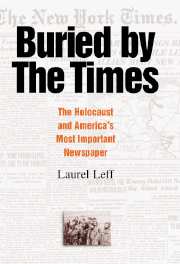Book contents
- Frontmatter
- Dedication
- Contents
- Acknowledgments
- Note Abbreviations
- Introduction: “Last Voice from the Abyss”
- PART I 1933—1941
- PART II 1942—1945
- 5 “To Awaken the Conscience of Christendom”: Pressure to Publicize the First News of the Extermination Campaign
- 6 “Amidst the Advertisements on Page 19”: Placement Decisions and the Role of the News Editors
- 7 “All Jews Are Not Brothers”: The Publisher's Fight with Zionists
- 8 “The Semitic Question Should Be Avoided”: German Atrocities and U.S. Government Propaganda
- 9 “Final Phase of Supreme Tragedy Has Begun”: The War Refugee Board and the Destruction of Hungary's Jews
- 10 “Political Prisoners, Slave Laborers, and Civilians of Many Nationalities”: The Liberation of the Concentration Camps
- 11 “Lessons from the Hitler Tragedy”: The Publisher and the Aftermath of War
- Conclusion: “The Horrible Story Was Not Told”
- Appendix A Key Individuals
- Appendix B Key Institutions
- Appendix C List of Front-Page Stories
- Notes
- Index
10 - “Political Prisoners, Slave Laborers, and Civilians of Many Nationalities”: The Liberation of the Concentration Camps
Published online by Cambridge University Press: 05 February 2015
- Frontmatter
- Dedication
- Contents
- Acknowledgments
- Note Abbreviations
- Introduction: “Last Voice from the Abyss”
- PART I 1933—1941
- PART II 1942—1945
- 5 “To Awaken the Conscience of Christendom”: Pressure to Publicize the First News of the Extermination Campaign
- 6 “Amidst the Advertisements on Page 19”: Placement Decisions and the Role of the News Editors
- 7 “All Jews Are Not Brothers”: The Publisher's Fight with Zionists
- 8 “The Semitic Question Should Be Avoided”: German Atrocities and U.S. Government Propaganda
- 9 “Final Phase of Supreme Tragedy Has Begun”: The War Refugee Board and the Destruction of Hungary's Jews
- 10 “Political Prisoners, Slave Laborers, and Civilians of Many Nationalities”: The Liberation of the Concentration Camps
- 11 “Lessons from the Hitler Tragedy”: The Publisher and the Aftermath of War
- Conclusion: “The Horrible Story Was Not Told”
- Appendix A Key Individuals
- Appendix B Key Institutions
- Appendix C List of Front-Page Stories
- Notes
- Index
Summary
In August 1945, a harrowing document landed on Arthur Sulzberger's desk. It described the wartime experiences of Elsbet Midas Gerst, a cousin of Erich Midas from Furth. The publisher had helped Erich, his wife Thea (Iphigene's cousin), and their young daughter immigrate to the United States 7 years earlier. The letter from Gerst to her parents and sisters had circulated among the Ochs relatives and someone had made sure Erich Midas' carefully translated version found its way to the New York Times.
Gerst and her husband had left Furth the same year as the Midases, escaping to the Netherlands – or so they thought. In July 1943, after the Gersts had spent 3 years living under harsh Nazi occupation, eight Gestapo men stormed their hiding place and Elsbet's excruciating odyssey began. After 3 weeks in a German prison, she was sent to Westerbork, a transit camp. A month later, Gerst, along with hundreds of others, was loaded into a cattle car, with one barrel for drinking water, and another as a toilet. It was August 24, 1943, her twenty-seventh birthday. The following night, the train arrived at Auschwitz.
One of 40 women to survive the selection process, Gerst was stripped, shaved, tattooed, dressed in dirty, torn clothes, and dumped in barracks with three tiers of beds. During her time in Auschwitz, Gerst underwent medical experiments and witnessed even worse conducted on others.
- Type
- Chapter
- Information
- Buried by the TimesThe Holocaust and America's Most Important Newspaper, pp. 294 - 318Publisher: Cambridge University PressPrint publication year: 2005



